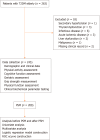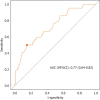Does low physical activity cause cognitive decline in elderly type 2 diabetes patients: A propensity score matching analysis
- PMID: 40548265
- PMCID: PMC12179912
- DOI: 10.4239/wjd.v16.i6.105496
Does low physical activity cause cognitive decline in elderly type 2 diabetes patients: A propensity score matching analysis
Abstract
Background: The relationship between low physical activity and cognitive impairment in type 2 diabetes mellitus (T2DM) patients remains unclear.
Aim: To explore this association and identify risk factors for cognitive impairment in elderly T2DM patients.
Methods: A retrospective analysis was conducted on 245 elderly T2DM patients treated at Xuanwu Hospital, Beijing, in 2023. Patients were categorized into low physical activity (n = 126) and non-low physical activity (n = 119) groups. After propensity score matching (PSM) of 100 pairs, univariate and binary logistic regression analyses identified risk factors for cognitive impairment. A predictive model was constructed and evaluated using receiver operating characteristic curve analysis.
Results: Before PSM, the percentage of cognitive impairment was higher in the low physical activity group (P < 0.05), but after PSM, this difference was not significant (P > 0.05). Additionally, on regression analyses after PSM, age, occupation type, history of stroke, malnutrition, and frailty remained independent factors associated with cognitive impairment, while low physical activity did not. The constructed risk prediction model for cognitive impairment in elderly T2DM patients exhibited an area under the curve of 0.77.
Conclusion: Low physical activity was not associated with cognitive impairment in our study population. Some results differed before and after PSM analysis, indicating that PSM supports objective assessment of risk factors by controlling for selection bias and confounding factors related to population characteristics. The constructed cognitive risk model provides insight for the development of a clinical tool for early prevention of cognitive impairment in elderly T2DM patients.
Keywords: Cognitive impairment; Low physical activity; Propensity score matching; Type 2 diabetes mellitus.
©The Author(s) 2025. Published by Baishideng Publishing Group Inc. All rights reserved.
Conflict of interest statement
Conflict-of-interest statement: The authors declare that they have no competing interests.
Figures



Similar articles
-
Diet, physical activity or both for prevention or delay of type 2 diabetes mellitus and its associated complications in people at increased risk of developing type 2 diabetes mellitus.Cochrane Database Syst Rev. 2017 Dec 4;12(12):CD003054. doi: 10.1002/14651858.CD003054.pub4. Cochrane Database Syst Rev. 2017. PMID: 29205264 Free PMC article.
-
Mild cognitive impairment is not predictive of dementia up to 15 years after subthalamic deep brain stimulation in Parkinson's disease.J Parkinsons Dis. 2025 Jun;15(4):879-891. doi: 10.1177/1877718X251334049. Epub 2025 May 20. J Parkinsons Dis. 2025. PMID: 40390641
-
Dipeptidyl-peptidase (DPP)-4 inhibitors and glucagon-like peptide (GLP)-1 analogues for prevention or delay of type 2 diabetes mellitus and its associated complications in people at increased risk for the development of type 2 diabetes mellitus.Cochrane Database Syst Rev. 2017 May 10;5(5):CD012204. doi: 10.1002/14651858.CD012204.pub2. Cochrane Database Syst Rev. 2017. PMID: 28489279 Free PMC article.
-
Intravenous versus inhalational maintenance of anaesthesia for postoperative cognitive outcomes in elderly people undergoing non-cardiac surgery.Cochrane Database Syst Rev. 2018 Aug 21;8(8):CD012317. doi: 10.1002/14651858.CD012317.pub2. Cochrane Database Syst Rev. 2018. PMID: 30129968 Free PMC article.
-
Enteral tube feeding for people with severe dementia.Cochrane Database Syst Rev. 2021 Aug 13;8(8):CD013503. doi: 10.1002/14651858.CD013503.pub2. Cochrane Database Syst Rev. 2021. PMID: 34387363 Free PMC article.
References
-
- Sun H, Saeedi P, Karuranga S, Pinkepank M, Ogurtsova K, Duncan BB, Stein C, Basit A, Chan JCN, Claude Mbanya J, Pavkov ME, Ramachandaran A, Wild SH, James S, Herman WH, Zhang P, Bommer C, Kuo S, Boyko EJ, Magliano DJ. Erratum to "IDF Diabetes Atlas: Global, regional and country-level diabetes prevalence estimates for 2021 and projections for 2045" [Diabetes Res. Clin. Pract. 183 (2022) 109119] Diabetes Res Clin Pract. 2023;204:110945. - PubMed
-
- Whitelock V, Rutters F, Rijnhart JJM, Nouwen A, Higgs S. The mediating role of comorbid conditions in the association between type 2 diabetes and cognition: A cross-sectional observational study using the UK Biobank cohort. Psychoneuroendocrinology. 2021;123:104902. - PubMed
-
- Livingston G, Huntley J, Liu KY, Costafreda SG, Selbæk G, Alladi S, Ames D, Banerjee S, Burns A, Brayne C, Fox NC, Ferri CP, Gitlin LN, Howard R, Kales HC, Kivimäki M, Larson EB, Nakasujja N, Rockwood K, Samus Q, Shirai K, Singh-Manoux A, Schneider LS, Walsh S, Yao Y, Sommerlad A, Mukadam N. Dementia prevention, intervention, and care: 2024 report of the Lancet standing Commission. Lancet. 2024;404:572–628. - PubMed
LinkOut - more resources
Full Text Sources
Miscellaneous

